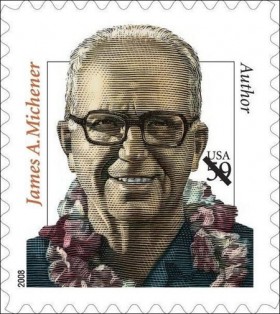Character consists of what you do on the third and fourth tries. ~James Michener
As an archaeology grad student, I decided to reread one of my favorite novels, The Source, to judge its accuracy.
The story takes place in Israel, on a mound (also known as a tel) formed by millennia of habitation. As each artifact comes to light, the story flashes back to its origin. The Source depicts awful excavation standards, even for the 1960s. But the artifacts reveal some incredible human stories.
Of course, you might think. That’s what archaeology does.
Not really.
In the early ’90s, archaeology still aspired to be a hard science. The “publish or perish” academic journals preferred articles steeped in the jargon of scientific method. For my masters thesis, I statistically analyzed thousands of flint waste flakes to discover signs of “sickle craft specialization as an indication of increasing social complexity.” Not like you see on TV.
I eventually chose storytelling over science, and skipped the Ph.d. program. I blame James Michener (1907-1997), author of The Source.
A Childhood Out of Dickens
The man who derailed my archaeology career didn’t know where or when he was born, but his best guess was around 1907. He was raised as a Quaker in Doylestown, Pennsylvania by an adoptive mother. They lived in extreme poverty and relocated often.
At Christmas, we rarely had anything. As a boy, I never had a pair of skates, never had a bicycle, never had a little wagon, never had a baseball glove, never had a pair of sneakers. I didn’t have anything. And do you know, at about seven or eight, I just decided, “Well, that’s the way it is. And I’m not going to beat my brains out about it.”
His mother loved literature, however, and often read to Michener from Dickens, Thackeray and Balzac.
Before Michener entered Swathmore College on a full scholarship, he peddled chestnuts, traveled America on a boxcar and did carnival private detective work. During college he was employed as a night watchman.
He graduated Swathmore with honors, and taught English and History for several years. In 1941, he became a textbook editor at Macmillan Publishing.
A Quaker Goes To War
Later that same year, Japanese military forces attacked Pearl Harbor. Michener waived his Quaker principles and volunteered for service. “I had taught about Hitler, and I had taught about the Japanese war machine, and I knew that this was a battle to the death, so I enlisted.”
The U.S. Navy assigned him to the Solomon Islands as a war historian. Each night, in his Quonset hut, he recorded his impressions of life around him:
Sitting there in the darkness, illuminated only by the flickering lamplight, I visualized the aviation scenes in which I had participated, the landing beaches I’d seen, the remote outposts, the exquisite islands with bending palms, and especially the valiant people I’d known: the French planters, the Australian coast watchers, the Navy nurses, the Tonkinese laborers, the ordinary sailors and soldiers who were doing the work, and the primitive natives to whose jungle fastnesses I had traveled.
Michener Lived By His Own Rules
Michener anonymously mailed his manuscript to Macmillan in 1947, since they had a strict policy against accepting employee submissions. He planned to return to his job after the war, but decided he was not technically their employee at the time.
Macmillan found him out, but decided to publish Tales of the South Pacific anyway. Michener was 40.
The following year, in 1948, it won the Pulitzer Prize for fiction.
The book was not a huge financial success, however, until it became the basis for Rodgers and Hammerstein’s musical, South Pacific.
In 1949, Michener quit Macmillan to write full time.
He penned 40 books over 50 years. Many were epics with evocative settings that spanned several generations. Some required so many years of research that Michener would spend months on location or even move there to finish them—Hawaii (1959), Iberia (1968), Poland (1983), Texas (1985), Alaska (1988), Mexico (1992).
 Michener Wrote His Own Ending
Michener Wrote His Own Ending
Even at age 90, he maintained a disciplined writing schedule. He awoke at 7:00 a.m., ate a light breakfast and wrote until 1:00 pm.
On Monday, Wednesday, and Friday, Michener underwent kidney dialysis treatment, which confined him to the environs of his clinic in Austin, Texas. “I sit in the TV room and see shows on the big ships I used to travel or areas that I used to wander, and a tear comes to my eye.”
In October 1997, he chose to discontinue dialysis and died shortly thereafter of renal failure.
A close friend said,
He felt he had accomplished what he wanted to accomplish in terms of his life’s work. He did not want to suffer a long series of complications.”
Late-Blooming Wisdom Inspired by James Michener
- Use your day job to advance your later blooming.
- If you begin at 40, you could have another good 50 years—over half your life—to live it.
Sources
- James Michener at Wikipedia
- His New York Times Obituary
- The Grand Times interview
- Opening Image: Palm Trees and Boulders in the Bay of Rio, Brazil by fellow late bloomer Marianne North (1873)
